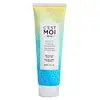What's inside
What's inside
 Key Ingredients
Key Ingredients

 Benefits
Benefits

 Concerns
Concerns

 Ingredients Side-by-side
Ingredients Side-by-side

Water
Skin ConditioningDecyl Glucoside
CleansingGlycerin
HumectantSodium Cocoyl Glutamate
CleansingPropanediol
SolventSodium Methyl Cocoyl Taurate
CleansingTriethyl Citrate
MaskingCitric Acid
BufferingParfum
MaskingSodium Benzoate
MaskingPropylene Glycol
HumectantCoco-Glucoside
CleansingGlyceryl Oleate
EmollientPolyquaternium-10
Leontopodium Alpinum Flower/Leaf Extract
Skin ConditioningTocopherol
AntioxidantHydrogenated Vegetable Glycerides Citrate
EmollientWater, Decyl Glucoside, Glycerin, Sodium Cocoyl Glutamate, Propanediol, Sodium Methyl Cocoyl Taurate, Triethyl Citrate, Citric Acid, Parfum, Sodium Benzoate, Propylene Glycol, Coco-Glucoside, Glyceryl Oleate, Polyquaternium-10, Leontopodium Alpinum Flower/Leaf Extract, Tocopherol, Hydrogenated Vegetable Glycerides Citrate
Water
Skin ConditioningGlycerin
HumectantSodium Cocoyl Glutamate
CleansingPropanediol
SolventXanthan Gum
EmulsifyingCaprylyl Glycol
EmollientCitric Acid
BufferingCoco-Glucoside
CleansingGlyceryl Oleate
EmollientCaprylhydroxamic Acid
Fragaria Vesca Fruit Extract
AstringentAloe Barbadensis Leaf Juice
Skin ConditioningPyrus Malus Fruit Extract
Skin ConditioningActinidia Chinensis Fruit Extract
EmollientCalendula Officinalis Flower Extract
MaskingSimmondsia Chinensis Seed Extract
AbrasiveWater, Glycerin, Sodium Cocoyl Glutamate, Propanediol, Xanthan Gum, Caprylyl Glycol, Citric Acid, Coco-Glucoside, Glyceryl Oleate, Caprylhydroxamic Acid, Fragaria Vesca Fruit Extract, Aloe Barbadensis Leaf Juice, Pyrus Malus Fruit Extract, Actinidia Chinensis Fruit Extract, Calendula Officinalis Flower Extract, Simmondsia Chinensis Seed Extract
 Reviews
Reviews

Ingredients Explained
These ingredients are found in both products.
Ingredients higher up in an ingredient list are typically present in a larger amount.
Citric Acid is an alpha hydroxy acid (AHA) naturally found in citrus fruits like oranges, lemons, and limes.
Like other AHAs, citric acid can exfoliate skin by breaking down the bonds that hold dead skin cells together. This helps reveal smoother and brighter skin underneath.
However, this exfoliating effect only happens at high concentrations (20%) which can be hard to find in cosmetic products.
Due to this, citric acid is usually included in small amounts as a pH adjuster. This helps keep products slightly more acidic and compatible with skin's natural pH.
In skincare formulas, citric acid can:
While it can provide some skin benefits, research shows lactic acid and glycolic acid are generally more effective and less irritating exfoliants.
Most citric acid used in skincare today is made by fermenting sugars (usually from molasses). This synthetic version is identical to the natural citrus form but easier to stabilize and use in formulations.
Read more about some other popular AHA's here:
Learn more about Citric AcidCoco-Glucoside is a surfactant, or a cleansing ingredient. It is made from glucose and coconut oil.
Surfactants help gather dirt, oil, and other pollutants from your skin to be rinsed away.
This ingredient is considered gentle and non-comedogenic. However, it may still be irritating for some.
Learn more about Coco-GlucosideGlycerin is already naturally found in your skin. It helps moisturize and protect your skin.
A study from 2016 found glycerin to be more effective as a humectant than AHAs and hyaluronic acid.
As a humectant, it helps the skin stay hydrated by pulling moisture to your skin. The low molecular weight of glycerin allows it to pull moisture into the deeper layers of your skin.
Hydrated skin improves your skin barrier; Your skin barrier helps protect against irritants and bacteria.
Glycerin has also been found to have antimicrobial and antiviral properties. Due to these properties, glycerin is often used in wound and burn treatments.
In cosmetics, glycerin is usually derived from plants such as soybean or palm. However, it can also be sourced from animals, such as tallow or animal fat.
This ingredient is organic, colorless, odorless, and non-toxic.
Glycerin is the name for this ingredient in American English. British English uses Glycerol/Glycerine.
Learn more about GlycerinGlyceryl Oleate is the ester of glycerin and oleic acid. This ingredient is mainly an emollient and emulsifier.
Emollients soften and hydrate the skin by creating a thin film on top to trap in moisture. As an emulsifier, glyceryl oleate helps stabilize formulations by preventing ingredients such as oil and water from separating. According to a manufacturer, this ingredient helps helps thicken water-in-oil formulations, shower gels, and hair shampoos.
In some products, this ingredient may be used as a fragrance / perfuming ingredient. The scent of this ingredient is described to be "waxy".
Glyceryl oleate is created from oils rich in oleic acid, such as peanut oil and olive oil.
This ingredient may not be malassezia folliculitis safe.
Learn more about Glyceryl OleatePropanediol is an all-star ingredient. It softens, hydrates, and smooths the skin.
It’s often used to:
Propanediol is not likely to cause sensitivity and considered safe to use. It is derived from corn or petroleum with a clear color and no scent.
Learn more about PropanediolSodium Cocoyl Glutamate is a gentle cleanser and surfactant. It is the sodium salt of the Cocoyl Glutamic Acid and comes from coconut oil. As a surfactant, it helps lift dirt and oil to be washed away.
Sodium Cocoyl Glutamate also has an emolliating effect and can help leave the skin feeling soft.
Water. It's the most common cosmetic ingredient of all. You'll usually see it at the top of ingredient lists, meaning that it makes up the largest part of the product.
So why is it so popular? Water most often acts as a solvent - this means that it helps dissolve other ingredients into the formulation.
You'll also recognize water as that liquid we all need to stay alive. If you see this, drink a glass of water. Stay hydrated!
Learn more about Water